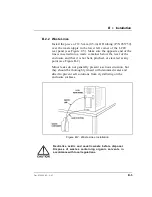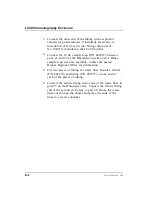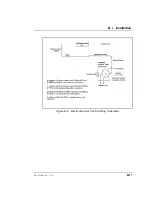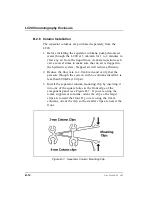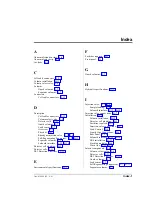
B
•
Installation
B.1 Facilities Required
Appendix A of this manual contains the complete LC20
specifications. The location selected to install the LC20 should also
meet the following requirements:
•
A sturdy table or work bench with at least 15 cm (6 in) free
space behind the module for connections and ventilation.
Maximum horizontal slope is 2-cm per lateral meter (0.25-inch
per lateral foot).
•
Nitrogen, argon, or helium gas cylinder for reservoir pressure.
•
As the enclosure does not have temperature control, the
environment will affect the enclosure operation. The system
should be installed with adequate ventilation and in an
environment that provides maximum consistency in ambient
temperature and humidity. In general, you should
— avoid sun and proximity to hot equipment.
— avoid heavy air drafts and sudden temperature changes
— not operate the enclosure in condensing atmospheres
— maintain specified ambient temperatures.
Connect gas/air pressure to the solenoids on the rear panel (see
Figure 2-5). The gas/air pressure is routed to the enclosure valves
through air valves, which are actuated electrically by the pump.
Connect the wiring to the proper connector on the pump according
to the plumbing schematics further in this chapter.
To avoid contamination and possible deterioration of the
valves, make sure laboratory pneumatic air, if used, is
oil-free, dry, and filtered, and maintained within the
pressure limits specified above.
Doc. 034859-02 9/93
B-3
Summary of Contents for LC20
Page 6: ...Contents iv Doc 034859 02 9 93 ...
Page 8: ...LC20 Chromatography Enclosure 1 2 Doc 034859 02 9 93 ...
Page 12: ...LC20 Chromatography Enclosure 2 2 Doc 034859 02 9 93 ...
Page 24: ...LC20 Chromatography Enclosure 2 14 Doc 034859 02 9 93 ...
Page 26: ...LC20 Chromatography Enclosure 3 2 Doc 034859 02 9 93 ...
Page 29: ...Figure 3 7 Drawing Sample 3 Operation and Maintenance Doc 034859 02 9 93 3 5 ...
Page 32: ...LC20 Chromatography Enclosure 3 8 Doc 034859 02 9 93 ...
Page 34: ...LC20 Chromatography Enclosure 4 2 Doc 034859 02 9 93 ...
Page 40: ...LC20 Chromatography Enclosure 4 8 Doc 034859 02 9 93 ...
Page 42: ...LC20 Chromatography Enclosure 5 2 Doc 034859 02 9 93 ...
Page 50: ...LC20 Chromatography Enclosure 5 10 Doc 034859 02 9 93 ...
Page 52: ...LC20 Chromatography Enclosure A 2 Doc 034859 02 9 93 ...
Page 56: ...LC20 Chromatography Enclosure B 2 Doc 034859 02 9 93 ...
Page 65: ...Figure B 6 Electrochemical Cell Plumbing Schematic B Installation Doc 034859 02 9 93 B 11 ...

















